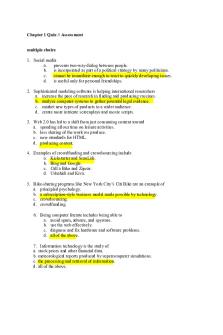Chapter 48 Practice Quiz PDF

| Title | Chapter 48 Practice Quiz |
|---|---|
| Author | Cecilia Villarreal |
| Course | Lab-Biol 1005-010 |
| Institution | University of Oklahoma |
| Pages | 3 |
| File Size | 70.3 KB |
| File Type | |
| Total Downloads | 26 |
| Total Views | 176 |
Summary
Download Chapter 48 Practice Quiz PDF
Description
Chapter 48 Practice Quiz 1. The nucleus and most of the organelles in a neuron are located in the a. Dendritic region b. Axon hillock c. Axon d. Cell body e. Axon terminals Most common neurons are motor neurons 2. In a simple synapse, neurotransmitter chemicals are released by a. The dendritic membrane b. The presynaptic membrane c. Axon hillocks d. Cell bodies e. Ducts on the smooth endoplasmic reticulum 3. For a neuron with an initial membrane potential at -70 mV, an increase in the movement of potassium ions out of that neuron’s cytoplasm would result in a. The depolarization of the neuron b. The hyperpolarization of the neuron c. The replacement of potassium ions with sodium ions d. The replacement of potassium ions with calcium ions e. The neuron switching on its sodium-potassium pump to restore the initial conditions Potassium is positive Positive charge leaving makes inside of cell more negativehyperpolarization 4. Although the membrane of a “resting” neuron is highly permeable to potassium ions, its membrane potential does not exactly match the equilibrium potential for potassium because the neuronal membrane is also a. Fully permeable to sodium ions b. Slightly permeable to sodium ions c. Fully permeable to calcium ions d. Impermeable to sodium ions e. Highly permeable to chloride ions 5. The membrane potential that exactly offsets an ion’s concentration gradient is called the a. Graded potential b. Threshold potential c. Equilibrium potential d. Action potential e. Inhibitory postsynaptic potential
Ion has equal conc on both sides, finding the charge difference when the element is in chemical equilibrium 6. A graded hyperpolarization of a membrane can be induced by a. Increasing its membrane’s permeability to Na+ b. Decreasing its membrane’s permeability to H+ c. Decreasing its membrane’s permeability to Cld. Increasing its membrane’s permeability to Ca+ e. Increasing its membrane’s permeability to K+, leaves inside of the cell more negative Inhibitory post synaptic potential Normally have a really high concentration of potassium inside the cell Increase permeability- add more channels Sodium and potassium 7. Action potentials more along axons a. More slowly in axons of large than in small diameter b. By the direct action of acetylcholine on the axonal membrane c. By activating the sodium-potassium “pump” at each point along the axonal membrane d. More rapidly in myelinated than in non-myelinated axons e. By reversing the concentration gradients for sodium and potassium ions
8. The undershoot phase of after-hyperpolarization is due to a. Slow opening of voltage-gated sodium channels b. Sustained opening of voltage-gated potassium channels c. Rapid opening of voltage-gated calcium channels d. Slow restorative actions of the sodium-potassium ATPase e. Ions that move away from their open ion channels 9. The release of acetylcholine from the terminal of a motor neuron is most directly linked to a. The entry of potassium into the axon terminal b. The exit of potassium from the axon terminal c. The entry of sodium into the axon terminal d. The exit of sodium from the axon terminal e. The entry of calcium into the axon terminal
10. The major inhibitory neurotransmitter of the human brain is a. Acetylcholine-excitatory, neuromuscular junction b. Epinephrine- excitatory, cause action potential c. Glutamate- major excitatory transmitter, opposite of GABA d. Nitric oxide- major vasodilator, not technically a neurotransmitter e. GABA Serotonin Dopamine...
Similar Free PDFs

Chapter 48 Practice Quiz
- 3 Pages

Chapter 24 quiz - Practice Quiz
- 3 Pages

Chapter 48 notes - Harvill
- 4 Pages

Chapter 1 - quiz practice
- 5 Pages

Chapter 7 Practice Quiz
- 19 Pages

Practice Quiz Chapter 3
- 6 Pages

Chapter 3 - quiz practice
- 5 Pages

Chapter 48: Nursing
- 4 Pages

48 Fray Luis - Apuntes 48
- 7 Pages

Chapter 7-8 Practice Quiz
- 7 Pages

Chapter 5 Practice Quiz KEY
- 2 Pages
Popular Institutions
- Tinajero National High School - Annex
- Politeknik Caltex Riau
- Yokohama City University
- SGT University
- University of Al-Qadisiyah
- Divine Word College of Vigan
- Techniek College Rotterdam
- Universidade de Santiago
- Universiti Teknologi MARA Cawangan Johor Kampus Pasir Gudang
- Poltekkes Kemenkes Yogyakarta
- Baguio City National High School
- Colegio san marcos
- preparatoria uno
- Centro de Bachillerato Tecnológico Industrial y de Servicios No. 107
- Dalian Maritime University
- Quang Trung Secondary School
- Colegio Tecnológico en Informática
- Corporación Regional de Educación Superior
- Grupo CEDVA
- Dar Al Uloom University
- Centro de Estudios Preuniversitarios de la Universidad Nacional de Ingeniería
- 上智大学
- Aakash International School, Nuna Majara
- San Felipe Neri Catholic School
- Kang Chiao International School - New Taipei City
- Misamis Occidental National High School
- Institución Educativa Escuela Normal Juan Ladrilleros
- Kolehiyo ng Pantukan
- Batanes State College
- Instituto Continental
- Sekolah Menengah Kejuruan Kesehatan Kaltara (Tarakan)
- Colegio de La Inmaculada Concepcion - Cebu




